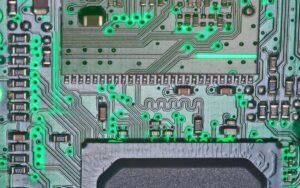Deepfake Risks
With the rapid advancement of technology, the creation and dissemination of deepfake content is becoming increasingly prevalent. These sophisticated manipulated videos, powered by artificial intelligence, raise significant concerns about the potential risks they pose to individuals, businesses, and society as a whole.
Key Takeaways:
- Deepfakes are highly realistic manipulated videos created using AI algorithms.
- Deepfakes pose risks to privacy, reputation, and cybersecurity.
- Regulation and technological advancements are needed to combat the threat of deepfake technology.
**Deepfakes** are produced using **advanced AI algorithms** that use deep learning techniques to generate fabricated content that appears genuine. These altered videos can superimpose the faces and voices of individuals onto completely unrelated footage, effectively creating convincing fake scenarios. *The rise of deepfake technology has become a double-edged sword, blurring the line between reality and fiction.*
Privacy Risks
One of the primary concerns surrounding deepfakes is their potential **invasion of privacy**. These videos can be used to manipulate and deceive, potentially involving innocent individuals in compromising or damaging situations. *Imagine discovering a fabricated video featuring yourself engaging in illegal activities online, tarnishing your reputation and affecting your personal life.* As deepfake technology becomes more accessible, the risk of privacy violations increases exponentially.
Reputation Damage
The implications of deepfakes extend beyond privacy invasion. **Reputation damage** is another significant risk associated with the spread of this technology. Purposefully altered videos can portray individuals saying and doing things they never did, impacting their personal and professional lives. *Imagine a high-profile executive falsely depicted in a video making derogatory comments about their own company, leading to severe consequences for their career and the company’s image.*
Cybersecurity Threats
Deepfakes are not just a threat to individuals but also to organizations. They represent a serious **cybersecurity threat**. Hackers can use these videos for malicious purposes, such as impersonating key personnel or gathering sensitive information, leading to financial losses or compromising national security. *The potential for deepfakes to be weaponized against governments and businesses is cause for great concern.*
Regulation and Technological Advancements
To combat the risks posed by deepfakes, a multifaceted approach is required. *Technological advancements* play a crucial role in developing robust detection methods to identify deepfake content. Likewise, *increased regulation* is needed to hold creators and disseminators of deepfakes accountable for their actions. Governments and organizations must collaborate to establish clear legal frameworks and penalties for those who exploit the technology for malicious purposes.
Addressing the Risks
Addressing the risks associated with deepfakes requires a collective effort from all stakeholders. This includes increased awareness and education regarding this technology’s potential risks and consequences. Additionally, investment in research and development is crucial to stay one step ahead of malicious actors. By promoting responsible use of AI and deploying advanced detection mechanisms, we can mitigate the harms caused by deepfakes and safeguard the integrity of our digital world.

Common Misconceptions
The Rise of Deepfake Risks
Deepfake technology has gained a significant amount of attention in recent years, with concerns and debates surrounding its potential risks. However, there are several common misconceptions that people often have when it comes to understanding these risks:
Misconception 1: Deepfakes are only used for entertainment purposes
- Deepfakes are not solely limited to being used for entertainment purposes, such as creating viral videos or humorous content.
- There is an increasing risk of deepfakes being used for malicious purposes, such as spreading disinformation, creating fake news, or even sabotaging political campaigns.
- It is crucial to recognize that deepfake technology can be exploited in various ways, and its potential risks extend beyond mere entertainment.
Misconception 2: Deepfakes are easily distinguishable from real videos
- People often assume that deepfake videos are easily detectable due to their unrealistic or unnatural appearance.
- However, the advancements in deepfake technology have made it increasingly difficult to differentiate between real and fake videos.
- With the use of sophisticated algorithms and machine learning techniques, deepfakes can now replicate human images, voices, and movements with remarkable accuracy.
Misconception 3: Deepfakes only target celebrities and public figures
- While there have been several high-profile cases of deepfake videos targeting celebrities and public figures, it is crucial to understand that anyone can become a victim.
- Deepfake technology can be used to manipulate and deceive ordinary individuals, leading to various personal, professional, and reputational consequences.
- From revenge porn to identity theft, deepfakes pose a threat to the privacy and security of individuals from all walks of life.
Misconception 4: Legislation can effectively tackle deepfake risks
- Some people believe that implementing legislation alone can effectively address the risks associated with deepfakes.
- While regulations can play a crucial role in creating a legal framework, it is important to acknowledge the inherent challenges of regulating deepfake technology.
- The rapidly evolving nature of deepfakes makes it difficult for legislation to keep pace, and sophisticated techniques can still be used to bypass legal restrictions.
Misconception 5: Deepfakes are a problem of the future
- Many individuals perceive deepfake risks as a potential threat that is still far off in the future.
- However, deepfakes are already impacting society in significant ways, and the potential for their misuse is only expected to grow.
- Recognizing the existing dangers and actively working towards addressing these risks is crucial to safeguarding individuals, societies, and the integrity of information.

The Rise of Deepfake Technology
In recent years, the emergence of deepfake technology has presented unprecedented challenges and risks. Deepfakes, which use artificial intelligence algorithms to create highly realistic manipulated media, have the potential to undermine trust in both our visual perception and the veracity of information. This article explores the various implications and risks associated with deepfakes through ten illustrative tables, shedding light on the urgency to address this growing concern.
Table: Deepfake Detection Techniques Comparison
This table compares the various detection techniques used to identify deepfake media. It highlights their strengths, limitations, and effectiveness in combatting the spread of manipulated media.
Table: Instances of Deepfake Misinformation Campaigns
This table documents notable instances where deepfake technology has been exploited to spread misinformation and influence public opinion. It highlights the impact of these campaigns on public discourse and the need for effective countermeasures.
Table: Deepfakes and Fraud Statistics
In this table, we present statistics on the rise of deepfake-related fraud cases. It provides insights into the financial implications and the growing need for robust fraud prevention measures.
Table: Social Media Platforms’ Policies on Deepfakes
This table analyzes the policies adopted by major social media platforms regarding the handling of deepfake content. It examines their approaches to content removal, fact-checking, and user awareness initiatives.
Table: Deepfake Impact on Elections
Through this table, we examine the potential impact of deepfake technology on democratic processes, focusing on its role in influencing voter behavior and spreading political disinformation.
Table: Deepfake Regulation by Country
In this table, we provide an overview of the regulatory approaches taken by different countries to address the risks posed by deepfake technology. It highlights the variations in legal frameworks and the challenges of international coordination.
Table: Deepfake Threats to National Security
This table outlines the potential threats posed by deepfakes to national security, including the manipulation of public sentiment, dissemination of false intelligence, and erosion of trust in institutions.
Table: Deepfake Forensic Analysis Tools Comparison
Here, we compare the different forensic analysis tools available for identifying deepfakes. The table highlights their reliability, accuracy, and usability, supporting the development of effective countermeasures.
Table: Deepfake Public Awareness and Education Initiatives
In this table, we explore the various public awareness and education initiatives that aim to inform individuals about the dangers of deepfakes. It assesses their reach, impact, and effectiveness in mitigating the risks associated with manipulated media.
Table: Deepfake vs. Authentic Media Accuracy
The final table examines the accuracy of deepfakes compared to authentic media. It showcases the level of realism achieved by deepfake technology, highlighting the challenges it poses to human perception and media verification.
In light of the widespread influence and potential harm caused by deepfake technology, it is clear that urgent action is required. To combat the risks associated with manipulated media, a multi-stakeholder approach encompassing technological advancements, robust regulation, and public education is crucial. By addressing deepfake risks head-on, we can safeguard public trust, protect democratic processes, and ensure the integrity of information in the digital age.
Deepfake Risks
Frequently Asked Questions
What are deepfakes?
What are the risks associated with deepfakes?
How can deepfakes impact individuals and businesses?
How can deepfake technology be misused?
What are the legal implications of deepfakes?
How can individuals protect themselves from deepfake risks?
Are there any tools or technologies available to detect deepfakes?
What role can social media platforms play in combating deepfakes?
What are the future implications of deepfakes?
Is it illegal to create or distribute deepfakes?




